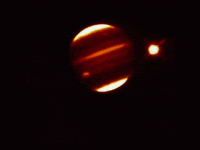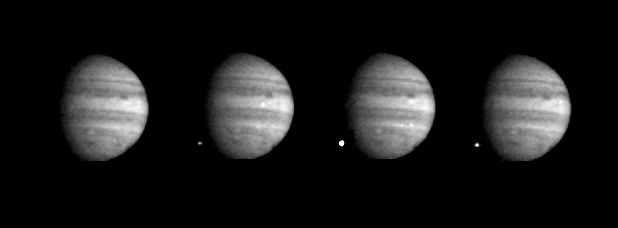A Comet Crashing Into Jupiter Gives Insight to What a Similar Impact Could Do to Earth
Florida Tech Research Analyzes the Collision of Shoemaker-Levy 9 into the Jovian Planet With Modern Instruments
A comet discovered on a crash course with Jupiter 23 years ago sparked a flurry of excitement in the astrophysics world: the event would become the first time scientists observed two solar system objects collide. The Hubble space telescope captured images of the impacts of the comet (which was in pieces as it descended into Jupiter’s atmosphere) and scientists had the opportunity to calculate the impacts’ immediate effect on the Jovian planet’s atmosphere and ring system.
Now, decades later, scientists are still gathering data from this rare cosmic event. Funded by NASA and the National Science Foundation, Florida Tech assistant physics professor Csaba Palotai continues to analyze the aftermath of the Shoemaker-Levy 9 event on Jupiter. Though lots of science was gathered at the time of the collisions in the 1990s, the chain of events such as enormous shock waves and ensuing bubbles and waves in Jupiter’s atmosphere as pieces of comet fell into the gas giant, can now be more accurately modeled with today’s sophisticated computing systems. Beyond learning how the comet affected Jupiter post-impact, Palotai says the data is helpful for calculating what effects such collisions could have here on Earth.
Though very unusual, comets and asteroids coming very close to Earth are not unheard of. In fact, many may remember that in 2012, a near-Earth asteroid entered the atmosphere at a shallow angle and exploded about 18 miles in the air above Chelyabinsk Oblast in Russia. The blast created a flash brighter than the sun and unexpectedly made a shock wave strong enough to break glass windows as it zoomed passed, causing damage to buildings and cars that led to injuries in its wake. According to Wikipedia, most of the object’s energy was absorbed by the atmosphere, but its total kinetic energy before atmospheric impact was equivalent to 500 kilotons of dynamite or about 29 times the energy released from the atomic bomb detonated at Hiroshima.
If it had made a direct hit on Earth, the impact could have been much worse for mankind. By studying those decades old impacts on Jupiter, Palotai and his students can make calculations on what the Earth could face in such an event and put clear and accurate warnings out that would save the most lives or prevent the most damage.
Hopefully a comet is not due to hit the Earth anytime soon (according to what we already know is out there) but comet impacts potentially have a life generating aspect to them, too. There are many theories that comets could have been the delivery system of the most basic building blocks of life to Earth and would eventually become all the flora and fauna there ever was. Studying the way a comet enters a planet’s atmosphere and the consequential impact could contribute to the understanding of how life unfolded here this planet or other planets in the universe.
%CODE1DISCOVERYMAGVOL13%






